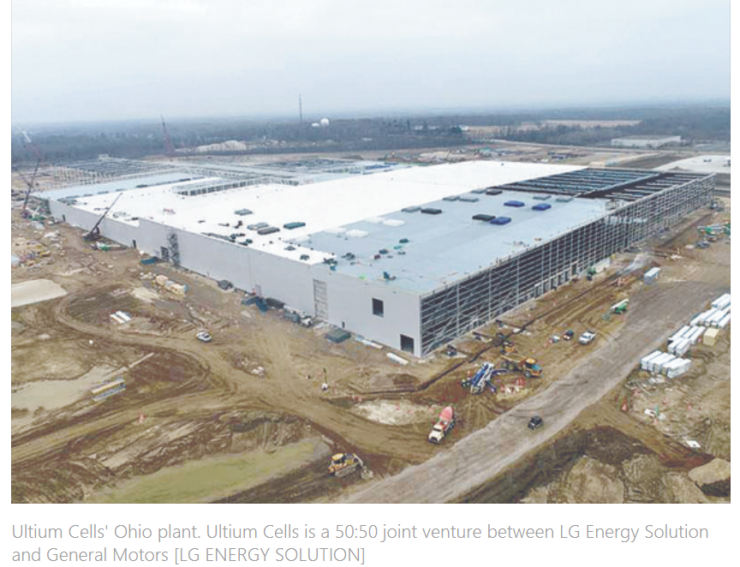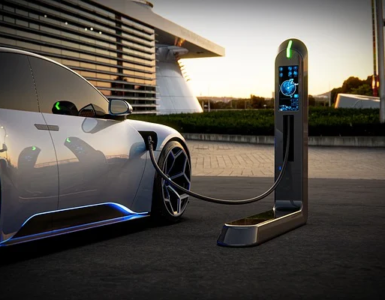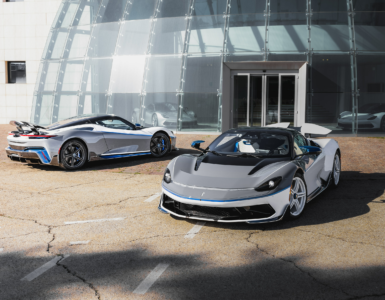In the global EV battery race, Korea makes big bet on Sun Belt.
Korea is moving rapidly to position itself as a leader in the global electric vehicle (EV) battery supply chain, with the three largest battery companies scrambling to pour billions into the North American region.
The Inflation Reduction Act (IRA) and financial aid from the U.S. government are accelerating the trend, with a growing number of global automakers considering Korean battery makers as a major alternative as the law tries to take China out of the equation.
The construction of a total of 11 joint battery factories worth billions of dollars was announced by battery makers and automakers in the North American region over the past three years, and of those, Korean battery companies are involved with nine.
Earlier in the week, the U.S. Energy Department said it has confirmed a $2.5 billion loan to Ultium Cells to finance its three battery manufacturing facilities in Ohio, Tennessee and Michigan. Ultium Cells is a 50-50 joint venture between LG Energy and General Motors.
The interest rate of the loan is on par with the 10-year U.S. Treasury yield of about 3.6 percent, approximately two percentage points lower than the rate a company with an AA rating would receive in the Korean bond market.
The three factories will give Ultium 145 gigawatt-hours of production capacity by the end of 2025, which is enough to produce 2 million EVs. The company ramped up the capacity by 25 gigawatt-hours from what it originally planned.
The announcement came around two weeks after Ultium announced an additional $275 million investment in its Tennessee plant. The Tennessee and Michigan plants are expected to start mass production in 2025, while the Ohio plant already began last month.
The aforementioned three are not the only plants LG Energy Solution has been working on. LG Energy is already building a $2.5 billion joint battery plant in Ontario, Canada, with Stellantis, with the goal of starting mass production in the first quarter of 2024.
In August, LG announced that it will build a $4.4 billion battery plant in Ohio jointly with Honda.
The battery maker already has an independent factory in Michigan, and is planning to build one in Arizona. It previously said that it will invest 1.7-trillion-won in an Arizona battery plant project, which will have 11 gigawatt-hours capacity, but announced that it is currently reassessing the plan.
🔥 What about we co-host a webinar? Let's educate, captivate, and convert the battery economy!
Batteries News is the global go-to online magazine for the battery industry, we can help you host impactful webinars that become a global reference on your topic and are an evergreen source of leads. Click here to request more details
Yoo Won-jae, a manager at LG Energy Solution’s communication team, said:
We will build the Arizona plant for sure, we already bought the site.
“We are just reconsidering the timing, amount, transactions and other details of the investment, but nothing has been decided yet.”
The largest battery plant in the United States is being built by BlueOval SK, a 50-50 joint venture between SK On and Ford Motor Company.
BlueOval recently broke ground on their two battery plants in Kentucky. The plants, which will be built on a 6.28-million-square-meter (67.6-million-square-feet) plot of land, will have a capacity of 86 gigawatt-hours annually.
When completed, the combined capacity of the three plants will be 129-gigawatt hours per year, which will be enough to supply batteries to some 1.2 million EVs. Mass production is expected to begin in the first quarter of 2025.
Lee Anna, an analyst at Yuanta Securities, said:
Korean companies had a 26.5 percent share of the U.S. EV battery market in 2021, and that will increase to some 70 percent by the end of 2025.
“With the recent U.S. movement to take China out of the equation, the rising EV market in the U.S. market will eventually raise demand for batteries from Korean battery makers.”
The combined capacity of the three Korean companies in the United States will surge 11-fold to 442 gigawatt-hours by the end of 2025, Lee added.
Samsung SDI partnered with Stellantis to jointly invest over $2.5 billion to build an EV battery plant in Kokomo, Indiana.
Ground will be broken within the year, with the goal of starting operations in the first quarter of 2025. The annual capacity will stand at 23 gigawatt-hours but could be increased to as much as 33 gigawatt-hours in the future.
Analyst Lee also estimates that the U.S. government will likely offer a total of 19 trillion won of incentives for Korean battery makers by 2025.
“That’s nearly half of the money the three Korean makers are estimated to invest in the United States by the end of 2025, which is roughly 40 trillion won in the United States.”
On Dec. 9, the Georgia government announced that Hyundai Motor and SK will jointly build a battery plant in Bartow County. The investment size is approximately $4 to 5 billion, the government said.
A spokesperson for SK On, said:
Nothing has been decided yet, SK On may build an independent factory there, or we may cooperate with Hyundai Motor.
Georgia is where the battery maker already has two plants. The first plant started production earlier in this year with a 9.8 gigawatt-hours capacity. The second plant is under construction with 11.7 gigawatt-hours.
The southern part of the United States, which is referred to as the Sun Belt, has been the most popular choice for Korean battery makers as a location for their manufacturing factories due to geographical and economic reasons.
With a warm and sunny climate, states in the Sun Belt usually have lower minimum salaries and taxes. Many states in the region also have a right-to-work law that gives workers the freedom to choose whether or not to join a labor union in the workplace.
The Tennessee government has no state minimum wage, so follows the current Federal minimum wage of $7.25 per hour. Georgia and Texas’ state minimum wage rate is also at $7.25 per hour, compared to California’s $14 and Washington D.C. at $16.10 per hour.
Lim Eun-young, an analyst at Samsung Securities, said:
Not only automakers in Korea, Japan and Germany but also U.S. companies like General Motors, Ford and Tesla are eying the southern areas for their new manufacturing plants.
States like Georgia, Kentucky and Tennessee are especially popular as they are geographically close to Canada, from which companies can source raw materials of batteries such as lithium and nickel.
Canada is home to 530,000 tons of lithium, 2.8 million tons of nickel and 220,000 tons of cobalt. It is the world’s fifth richest country in terms of nickel reserves and the third largest for cobalt.
Kim Pil-soo, an automotive engineering professor at Daelim University, said:
The passage of the IRA has fueled the trend of making joint battery facilities between automakers and battery makers.
“In the long term, the IRA will be an opportunity for Korean companies as the U.S. EV market is growing at a very fast speed and it tries to exclude China from the game, the major competitors of Korean companies.”
So far, only four percent of vehicles on the roads in the United States are EVs, compared to Europe’s 14 percent and China’s 11 percent. The Biden administration is pushing hard to increase that figure to 50 percent by 2030.
READ the latest Batteries News shaping the battery market
In the global EV race, Korea makes big bet on Sun Belt, December 18, 2022








